
Video Upload Options
The chital (/tʃiːtəl/; Axis axis), also known as spotted deer, chital deer, and axis deer, is a species of deer that is native to the Indian subcontinent. It was first described by German naturalist Johann Christian Polycarp Erxleben in 1777. A moderate-sized deer, male chital reach nearly 90 cm (35 in) and females 70 cm (28 in) at the shoulder. While males weigh 30–75 kg (66–165 lb), the lighter females weigh 25–45 kg (55–99 lb). It is sexually dimorphic; males are larger than females, and antlers are present only on males. The upper parts are golden to rufous, completely covered in white spots. The abdomen, rump, throat, insides of legs, ears, and tail are all white. The antlers, three-pronged, are nearly 1 m (3.3 ft) long.
1. Etymology
The vernacular name "chital" (pronounced /tʃiːtəl/)[1] comes from cītal (Hindi: चीतल), derived from the Sanskrit word citrala (चित्रलः), meaning "variegated" or "spotted".[2] The name of the cheetah has a similar origin.[3] Variations of "chital" include "cheetal" and "cheetul".[4] Other common names for the chital are Indian spotted deer (or simply the spotted deer) and axis deer.[5]
2. Taxonomy and Phylogeny
The chital was first described by German naturalist Johann Christian Polycarp Erxleben in 1777 as Cervus axis.[6] In 1827, English naturalist Charles Hamilton Smith placed the chital in its own subgenus, Axis, under the genus Cervus.[7][8] Later Axis was elevated to generic status by taxonomists such as Colin P. Groves and Peter Grubb.[9] In the past Hyelaphus – comprising the Bawean deer (H. kuhli), the Calamian deer (H. calamianensis ), and the hog deer (H. porcinus) – was considered a subgenus of Axis.[10] However a morphological analysis in 2004 showed significant differences between Axis and Hyelaphus.[11] A phylogenetic study later that year showed that Hyelaphus is closer to the genus Rusa than Axis. Axis was revealed to be paraphyletic and distant from Hyelaphus in the phylogenetic tree; the chital was found to form a clade with Rucervus duvaucelii (barasinga) and R. schomburgki (Schomburgk's deer). The chital was estimated to have diverged from the Rucervus lineage in the Early Pliocene (five million years ago). The following cladogram is based on the 2004 phylogenetic study:[12]

Fossils of extinct Axis species dating to the early to middle Pliocene are known from central to southern Asia from Iran in the west to Indochina in the east.[13]
3. Description
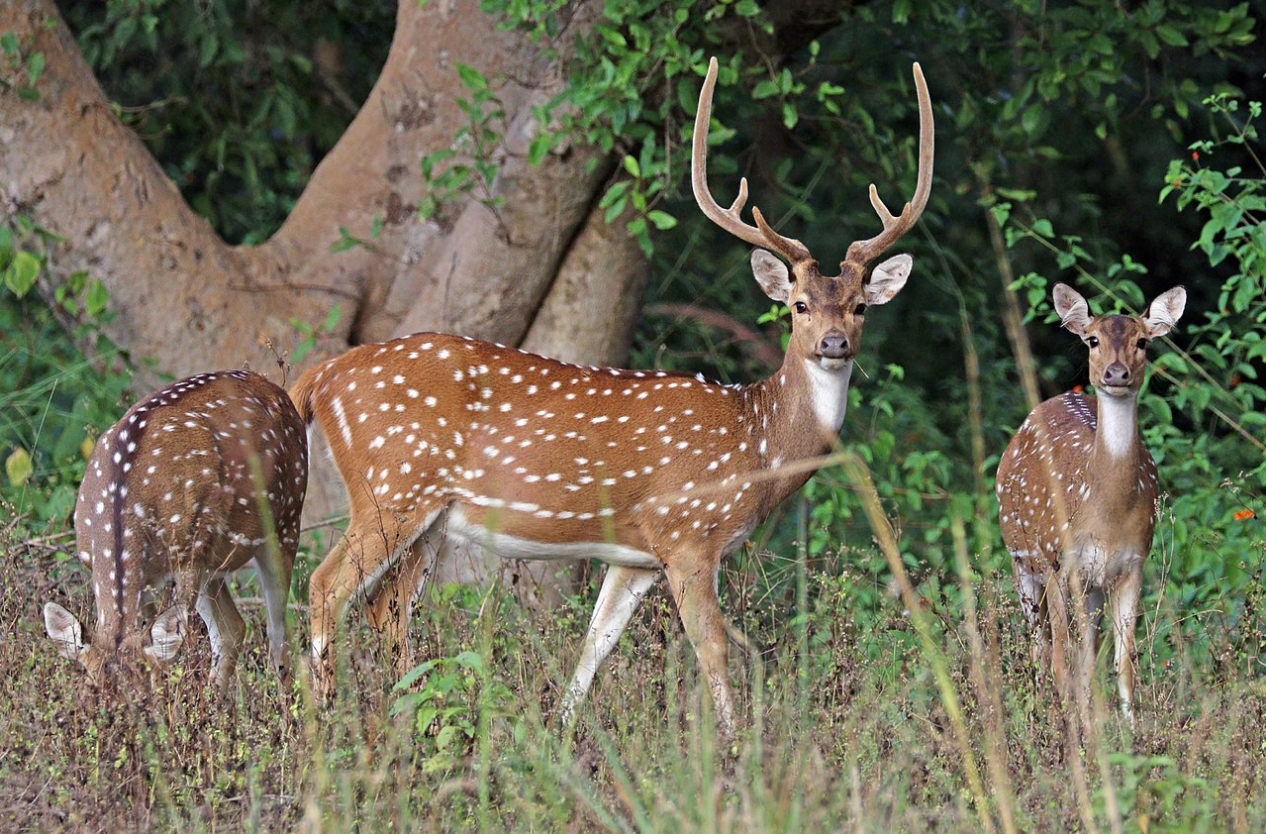
The chital is a moderately sized deer. Males reach nearly 90 cm (35 in) and females 70 cm (28 in) at the shoulder; the head-and-body length is around 1.7 m (5.6 ft). While immature males weigh 30–75 kg (66–165 lb), the lighter females weigh 25–45 kg (55–99 lb). Mature males can weigh up to 98 to 110 kg (216 to 243 lb).[14] The tail, 20 cm (7.9 in) long, is marked by a dark stripe that stretches along its length. The species is sexually dimorphic; males are larger than females, and antlers are present only on males.[15]
The dorsal (upper) parts are golden to rufous, completely covered in white spots. The abdomen, rump, throat, insides of legs, ears, and tail are all white.[15] A conspicuous black stripe runs along the spine (back bone).[16] The chital has well-developed preorbital glands (near the eyes) with stiff hairs.[17] It also has well-developed metatarsal glands and pedal glands located in its hind legs. The preorbital glands, larger in males than in females, are frequently opened in response to certain stimuli.[18][19]
Each of the antlers has three lines on it. The brow tine (the first division in the antler) is roughly perpendicular to the beam (the central stalk of the antler).[15] The antlers, three-pronged, are nearly 1 m (3.3 ft) long.[20] Antlers, as in most other cervids, are shed annually. The antlers emerge as soft tissues (known as velvet antlers) and progressively harden into bony structures (known as hard antlers), following mineralisation and blockage of blood vessels in the tissue, from the tip to the base.[21][22] A study of the mineral composition of the antlers of captive barasinga, chital, and hog deer showed that the antlers of the deer are very similar. The mineral content of the chital's antlers was determined to be (per kg) 6.1 milligrams (0.00022 oz) copper, 8.04 milligrams (0.000284 oz) cobalt, and 32.14 milligrams (0.001134 oz) zinc.[23]
Hooves measure between 4.1 and 6.1 cm (1.6 and 2.4 in) in length; hooves of the fore legs are longer than those of the hind legs. The toes taper to a point.[14] The dental formula is 0.1.3.33.1.3.3, same as the elk.[15] The milk canine, nearly 1 cm (0.39 in) long, falls off before one year of age, but is not replaced by a permanent tooth as in other cervids.[17]
Compared to the hog deer, the chital has a more cursorial build. The antlers and brow tines are longer than those in the hog deer. The pedicles (the bony cores from which antlers arise) are shorter, and the auditory bullae are smaller in the chital.[17] The chital may be confused with the fallow deer. Chital have several white spots, whereas fallow deer usually have white splotches. Fallow also have palmate antlers whereas chital have 3 distinct points on each side. The chital has a prominent white patch on its throat, while the throat of the fallow deer is completely white. The biggest distinction is the dark brown stripe running down the chital's back.[24] The hairs are smooth and flexible.[14]
4. Distribution and Habitat
The chital ranges over 8–30°N in India and through Nepal, Bhutan, Bangladesh, and Sri Lanka.[25] The western limit of its range is eastern Rajasthan and Gujarat. The northern limit is along the Bhabar-terai belt of the foothills of the Himalaya and from Uttar Pradesh and Uttaranchal through to Nepal, northern West Bengal and Sikkim and then to western Assam and the forested valleys of Bhutan, which are below 1,100 m asl.[5] The eastern limit of its range is through western Assam[26][27] to the Sunderbans of West Bengal (India) and Bangladesh.[5] Sri Lanka is the southern limit.[28] Chital occur sporadically in the forested areas throughout the rest of the Indian peninsula.[29] Within Bangladesh, it currently only exists in the Sundarbans and some ecoparks situated around the Bay of Bengal, as it became extinct in the central and north-east of the country.[5]
4.1. Australia
The chital was the first species of deer introduced into Australia in the early 1800s by Dr. John Harris, surgeon to the New South Wales Corps, and he had about 400 of these animals on his property by 1813. These did not survive, and the primary range of the chital is now confined to a few cattle stations in North Queensland near Charters Towers and several feral herds on the NSW north coast. While some of the stock originated from Sri Lanka (Ceylon), the Indian race likely is also represented.[30][31]
4.2. The United States
In the 1860s, axis deer were introduced to the island of Molokai, Hawaii, as a gift from Hong Kong to King Kamehameha V. The deer were introduced to Lanai, another of the Hawaiian Islands, soon afterward and are now plentiful on both islands. The deer were introduced to Maui island in the 1950s to increase hunting opportunities. Because the deer have no natural predators on the Hawaiian islands, their population is growing 20 to 30% each year, causing serious damage to agriculture and natural areas.[32]
Releasing them on the island of Hawaii was planned, as well, but this was abandoned after pressure from scientists over damage to landscapes caused by the deer on other islands. In 2012, deer were spotted on the island of Hawaii; wildlife officials believe people had flown the deer by helicopter and transported them by boat onto the island. In August 2012, a helicopter pilot pleaded guilty to transporting four axis deer from Maui to Hawaii.[33] Hawaiian law now prohibits "the intentional possession or interisland transportation or release of wild or feral deer."[34]
In 1932, axis deer were introduced to Texas . In 1988, self-sustaining herds were found in 27 counties, located in Central and South Texas.[35] The deer are most populous on the Edwards Plateau, where the land is similar to that of India.[36]
4.3. Croatia
Chital of unknown genetic origin were introduced to Brijuni Island in 1911, where they still occur today. They can also be found on Rab Island, and the population on the two islands amounts to some 200 individuals. Attempts by hunters to introduce the species to the mainland of Croatia were unsuccessful.[37]
5. Behaviour and Ecology
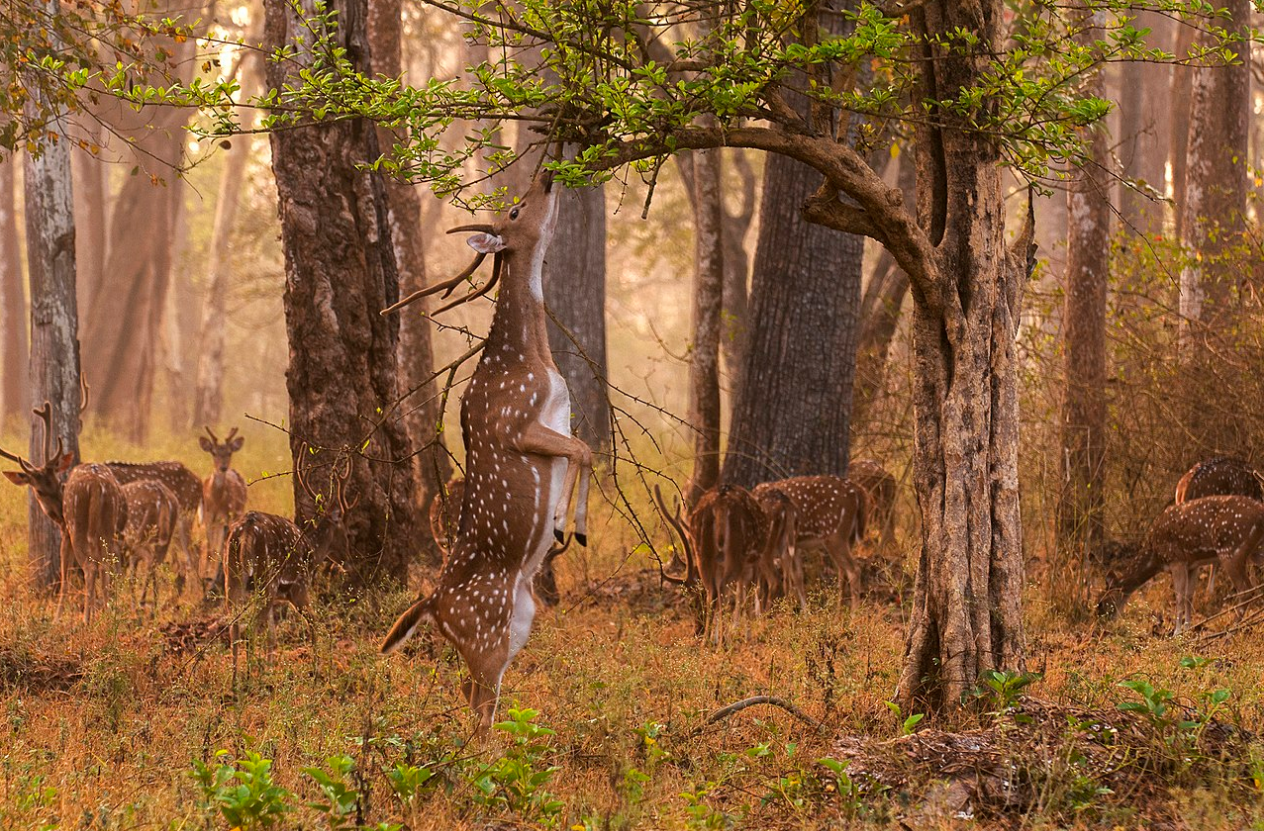
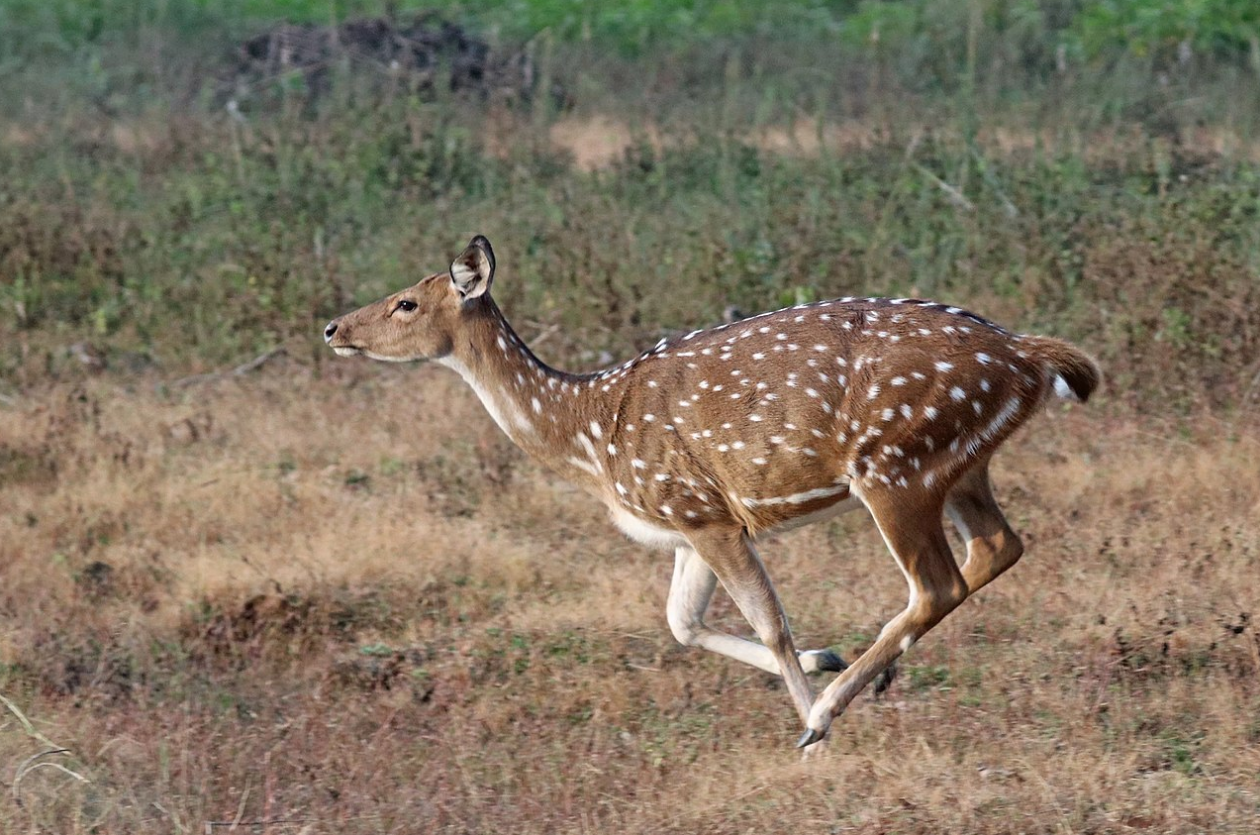
Chital are active throughout the day. In the summer, time is spent in rest under shade, and the sun's glare is avoided if the temperature reaches 80 °F (27 °C); activity peaks as dusk approaches. As days grow cooler, foraging begins before sunrise and peaks by early morning. Activity slows down during midday, when the animals rest or loiter about slowly. Foraging recommences by late afternoon and continues till midnight. They fall asleep a few hours before sunrise, typically in the forest which is cooler than the glades.[28] These deer typically move in a single file on specific tracks, with a distance of two to three times their width between them, when on a journey, typically in search of food and water sources.[15] A study in the Gir National Park (Gujarat, India) showed that chital travel the most in summer of all seasons.[38]
When cautiously inspecting its vicinity, the chital stands motionless and listens with rapt attention, facing the potential danger, if any. This stance may be adopted by nearby individuals, as well. As an antipredator measure, chital flee in groups (unlike the hog deer that disperse on alarm); sprints are often followed by hiding in dense undergrowth. The running chital has its tail raised, exposing the white underparts.[28] The chital can leap and clear fences as high as 1.5 m (4.9 ft) but prefers to dive under them. It stays within 300 m (980 ft) of cover.[17]
A gregarious animal, the chital forms matriarchal herds comprising an adult female and her offspring of the previous and the present year, which may be associated with individuals of any age and either sex, male herds, and herds of juveniles and mothers.[20][39] Small herds are common, though aggregations of as many as 100 individuals have been observed.[15] Groups are loose and disband frequently, save for the juvenile-mother herd.[40] Herd membership in Texas is typically up to 15;[20] herds can have five to 40 members in India.[28][41] Studies in the Nallamala Hills (Andhra Pradesh, India) and the Western Ghats (western coast of India) showed seasonal variation in the sex ratio of herds; this was attributed to the tendency of females to isolate themselves ahead of parturition. Similarly, rutting males leave their herds during the mating season, hence altering the herd composition.[39] Large herds were most common in monsoon, observed foraging in the grasslands.[41] Predators of the chital include wolves, Bengal tigers, Asiatic lions, leopards, Indian rock pythons, dholes, Indian pariah dogs, and mugger crocodiles. Red foxes and golden jackals target juveniles. Males are less vulnerable than females and juveniles.[17][28]
A vocal animal, the chital, akin to the North American elk, gives out bellows and alarm barks.[15] Its calls are, however, not as strong as those of elk or red deer; they are mainly coarse bellows or loud growls.[17] Bellowing coincides with rutting.[28][42] Dominant males guarding females in oestrus make high-pitched growls at less powerful males.[17] Males may moan during aggressive displays or while resting.[20] Chital, mainly females and juveniles, bark persistently when alarmed or if they encounter a predator. Fawns in search of their mother often squeal. The chital can respond to the alarm calls of several animals, such as the common myna and langurs.[17]
Marking behaviour is pronounced in males. Males have well-developed preorbital glands (near the eyes). They stand on their hind legs to reach tall branches and rub the open preorbital glands to deposit their scent there. This posture is also used while foraging. Urine marking is also observed; the smell of urine is typically stronger than that of the deposited scent. Sparring between males begins with the larger male displaying his dominance before the other; this display consists of hissing heading away from the other male with the tail facing him, the nose pointing to the ground, the ears down, the antlers upright, and the upper lip raised. The fur often bristles during the display. The male approaches the other in a slow gait. Males with velvet antlers may hunch over instead of standing erect as the males with hard antlers. The opponents then interlock their horns and push against each other, with the smaller male producing a sound at times which is louder than that produced by sambar deer, but not as much as the barasinga's. The fight terminates with the males stepping backward, or simply leaving and foraging.[17] Fights are not generally serious.[28]
Individuals may occasionally bite one another.[17] Common mynas are often attracted to the chital.[14] An interesting relationship has been observed between herds of chital and troops of the northern plains grey langurs, a widespread South Asian monkey. Chital benefit from the langurs' eyesight and ability to post a lookout from trees, while the langur benefit from the chital's strong sense of smell, both of which help keep a check on potential danger.[28] The chital also benefit from fruits dropped by langurs from trees such as Terminalia bellirica and Phyllanthus emblica.[43][44] The chital has been observed foraging with sambar deer in the Western Ghats.[39]
2.1. Diet
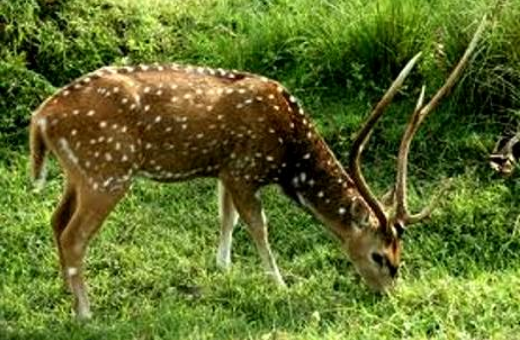
Grazers as well as browsers, the chital mainly feed on grasses throughout the year. They prefer young shoots, in the absence of which, tall and coarse grasses are nibbled off at the tips. Browse forms a major portion of the diet only in the winter-October to January-when the grasses, tall or dried up, are no longer palatable. Browse includes herbs, shrubs, foliage, fruits, and forbs; Moghania species are often preferred while browsing. Fruits eaten by chital in the Kanha National Park (Madhya Pradesh, India) include those of Ficus species from January to May, Cordia myxa from May to June, and Syzygium cumini from June to July. Individuals tend to group together and forage while moving slowly.[28] Chital are generally silent when grazing together. Males often stand on their hindlegs to reach tall branches. Water holes are visited nearly twice daily, with great caution.[17] In the Kanha National Park, mineral licks rich in calcium and phosphorus pentoxide were scraped at by the incisors. Chital in the Sunderbans may be omnivores; remains of red crabs have been found in the rumen of individuals.[28]
2.2. Reproduction
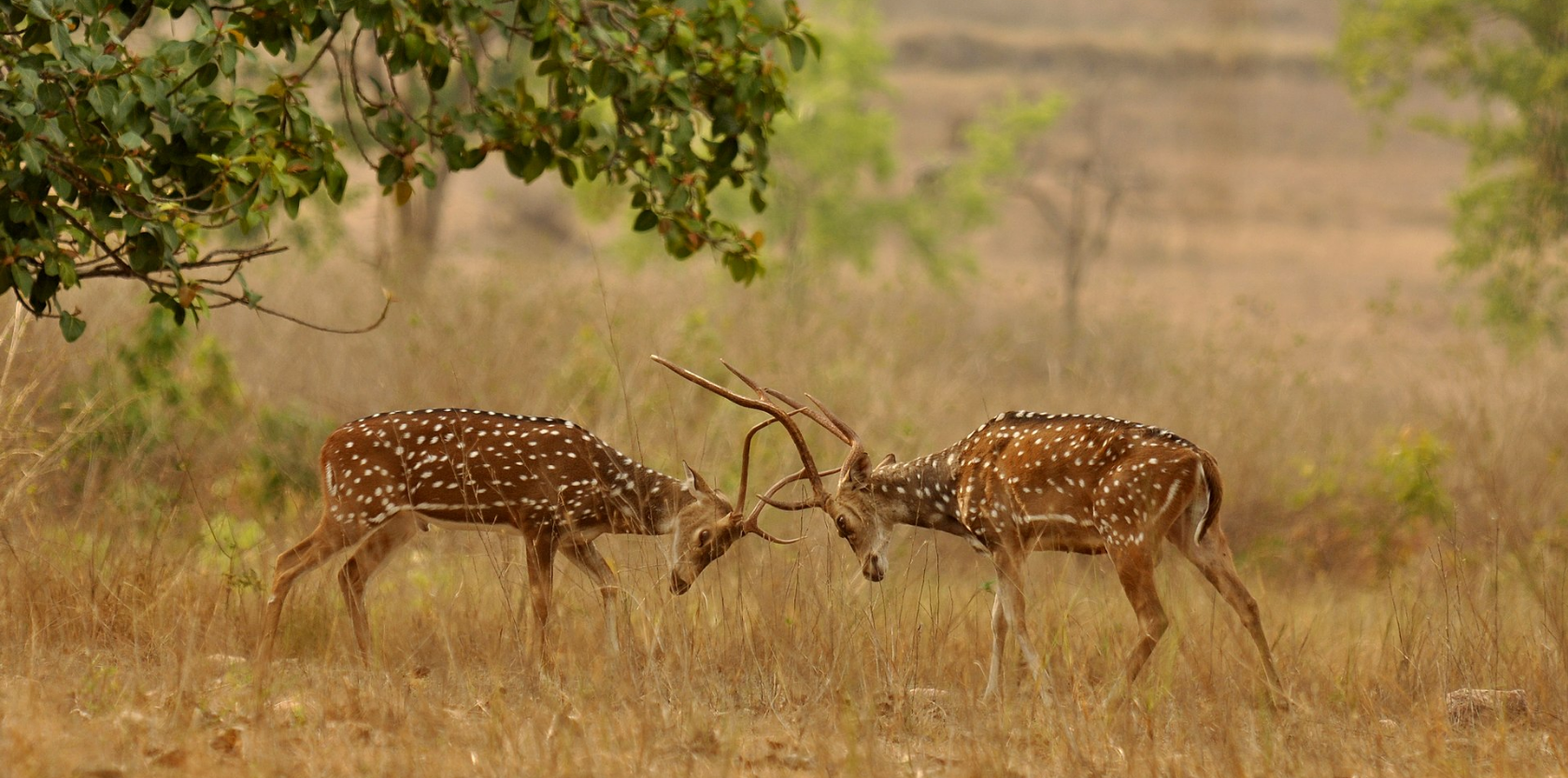
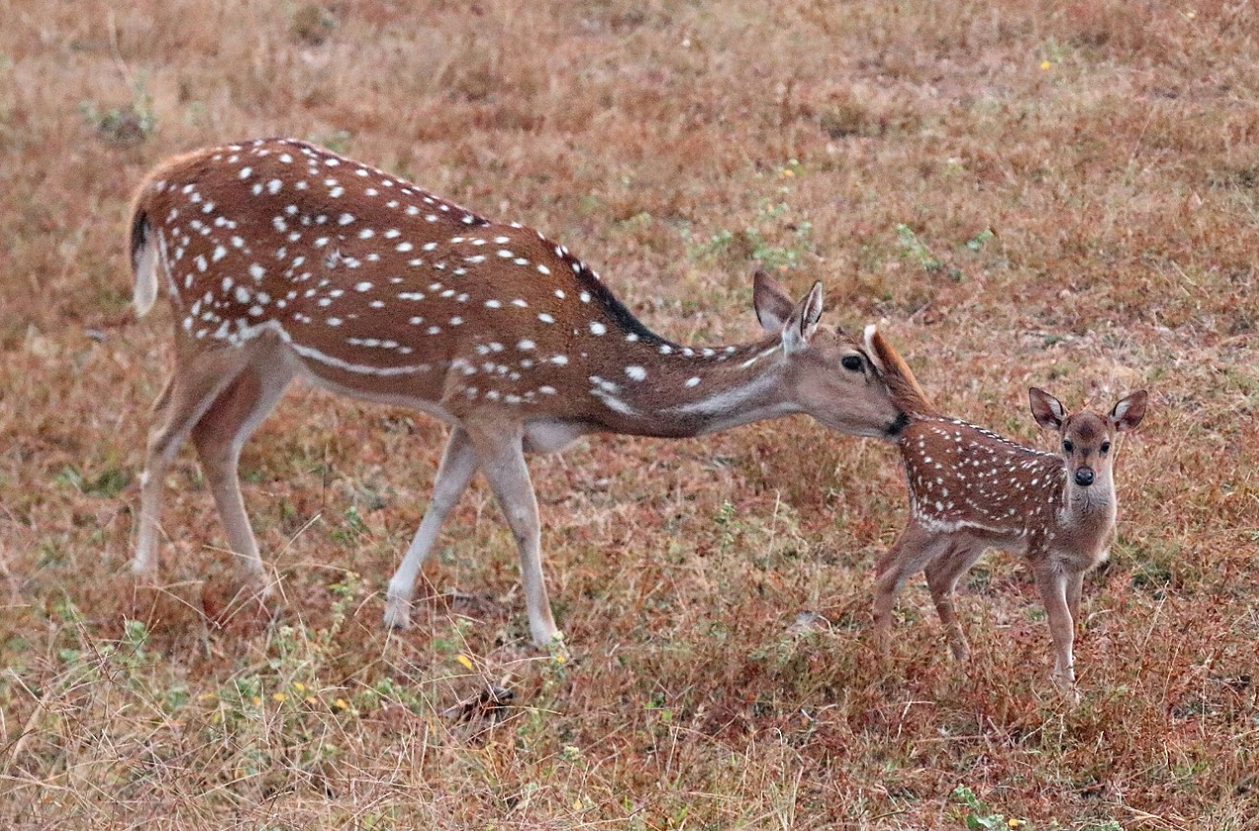
Breeding takes place throughout the year, with peaks that vary geographically. Sperm is produced year-round, though testosterone levels register a fall during the development of the antlers. Females have regular oestrus cycles, each lasting three weeks. The female can conceive again two weeks to four months after the birth. Males sporting hard antlers are dominant over those in velvet or those without antlers, irrespective of their size. Courtship is based on tending bonds. A rutting male fasts during the mating season and follows and guards a female in oestrus. The pair does several bouts of chasing and mutual licking before copulation.[17]
The newborn is hidden for a week after birth, a period much shorter than most other deer. The mother-fawn bond is not very strong, as the two get separated often, though they can reunite easily as the herds are cohesive. If the fawn dies, the mother can breed once again so as to give birth twice that year. The males continue their growth till seven to eight years. The average lifespan in captivity is nearly 22 years. The longevity in the wild, however, is merely five to ten years.[17][28]
The chital is found in large numbers in dense deciduous or semievergreen forests and open grasslands.[28] The highest numbers of chital are found in the forests of India, where they feed upon tall grass and shrubs. Chital have been also spotted in Phibsoo Wildlife Sanctuary in Bhutan, which has the only remaining natural sal (Shorea robusta) forest in the country. They do not occur at high altitudes, where they are usually replaced by other species such as the sambar deer. They also prefer heavy forest cover for shade and avoid direct sunlight.[17]
6. Conservation Status
The chital is listed by the IUCN as being of least concern "because it occurs over a very wide range within which there are many large populations".[5] Currently, no range-wide threats to chitals are present, and they live in many protected areas. However, population densities are below ecological carrying capacity in many places due to hunting and competition with domestic livestock. Hunting for the deer's meat has caused substantial declines and local extinctions.[5] The axis deer is protected under Schedule III of the Indian Wildlife Protection Act (1972)[29] and under the Wildlife (Preservation) (Amendment) Act, 1974 of Bangladesh.[5] Two primary reasons for its good conservation status are its legal protection as a species and a network of functioning protected areas.[5]
The chital has been introduced to the Andaman Islands, Argentina , Australia , Brazil , Chile , Mexico, Paraguay, Uruguay, Alabama, Point Reyes National Seashore in California , Florida, Hawaii, Mississippi, and Texas in the United States, and the Veliki Brijun Island in the Brijuni Archipelago of the Istrian Peninsula in Croatia.[5][45][46]
References
- "Chital". Dictionary.com Unabridged. Random House. https://www.dictionary.com/browse/Chital.
- Platts, J. T. (1884). "चीतल ćītal". A Dictionary of Urdu, Classical Hindi, and English. London: W. H. Allen & Co. p. 470. https://dsal.uchicago.edu/cgi-bin/app/platts_query.py?qs=%E0%A4%9A%E0%A5%80%E0%A4%A4%E0%A4%B2&matchtype=default.
- "Cheetah". Merriam-Webster Dictionary. https://www.merriam-webster.com/dictionary/Cheetah. Retrieved 10 March 2016.
- "Chital". Merriam-Webster Dictionary. https://www.merriam-webster.com/dictionary/Chital. Retrieved 24 December 2019.
- Duckworth, J.W.; Kumar, N.S.; Anwarul Islam, M.; Sagar Baral, H.; Timmins, R. (2015). "Axis axis". IUCN Red List of Threatened Species 2015: e.T41783A22158006. https://www.iucnredlist.org/species/41783/22158006.
- Erxleben, J. C. P. (1777). "Axis" (in la). Systema Regni Animalis per Classes, Ordines, Genera, Species, Varietates cvm Synonymia et Historia Animalivm. p. 312. https://archive.org/details/iochristpolycerx00erxl/page/312.
- Cuvier, G. (1827). The Animal Kingdom arranged in Conformity with its Organization. Volume 5. London: William Clowes. p. 312. https://books.google.com/books?id=VexZAAAAcAAJ&pg=PA312.
- Wilson, D.E.; Reeder, D.M., eds (2005). Mammal Species of the World: A Taxonomic and Geographic Reference (3rd ed.). Johns Hopkins University Press. p. 661. ISBN 978-0-8018-8221-0. OCLC 62265494. http://www.departments.bucknell.edu/biology/resources/msw3/browse.asp?id=14200345.
- Groves, C. P; Grubb, P (1987). "Relationships of living deer". in Wemmer, C. M.. Biology and Management of the Cervidae. Washington, D.C.: Smithsonian Institution Press. pp. 21–59. ISBN 978-0-87474-980-9.
- Srinivasulu, C.; Srinivasulu, B. (2012). South Asian Mammals: their Diversity, Distribution, and Status. New York: Springer. pp. 357–358. ISBN 978-1-4614-3449-8. https://books.google.com/books?id=PEsIul417ewC&pg=PA357.
- Meijaard, E.; Groves, C. (2004). "Morphometrical relationships between South-east Asian deer (Cervidae, tribe Cervini): evolutionary and biogeographic implications". Journal of Zoology 263 (2): 179–196. doi:10.1017/S0952836904005011. https://www.academia.edu/16340041.
- Pitra, C.; Fickel, J.; Meijaard, E.; Groves, C. (2004). "Evolution and phylogeny of old world deer". Molecular Phylogenetics and Evolution 33 (3): 880–895. doi:10.1016/j.ympev.2004.07.013. PMID 15522810. https://www.academia.edu/5383289.
- Di Stefano, G.; Petronio, C. (2002). "Systematics and evolution of the Eurasian Plio-Pleistocene tribe Cervini (Artiodactyla, Mammalia)". Geologica Romana 36 (311): e334. http://tetide.geo.uniroma1.it/dst/grafica_nuova/pubblicazioni_DST/geologica_romana/Volumi/VOL%2036/GR_36_311_334_DI%20Stefano%20et%20al.pdf.
- Waring, G.H. (1996). "Preliminary study of the behavior and ecology of axis deer on Maui, Hawaii". Online Report Presented by the Hawaii Ecosystems at Risk (HEAR) Project. http://www.hear.org/AlienSpeciesInHawaii/waringreports/axisdeer.htm.
- Schmidly, D.J. (2004). The Mammals of Texas (Revised ed.). Austin, Texas (USA): University of Texas Press. pp. 263–264. ISBN 978-1-4773-0886-8. http://www.nsrl.ttu.edu/tmot1/cervaxis.htm.
- Kays, R.W.; Wilson, D.E. (2009). Mammals of North America (2nd ed.). Princeton, New Jersey (USA): Princeton University Press. p. 166. ISBN 978-069114092-6.
- Geist, V. (1998). Deer of the World: their Evolution, Behaviour and Ecology (1st ed.). Mechanicsburg, Pennsylvania: Stackpole Books. pp. 58–73. ISBN 978-081170496-0. https://books.google.com/books?id=bcWZX-IMEVkC&pg=PA58.
- Groves, C.; Grubb, P. (1982). "Relationships of living deer". Biology and Management of the Cervidae: A Conference Held at the Conservation and Research Center, National Zoological Park, Smithsonian Institution, Front Royal, Virginia, 1–5 August 1982: 21–59.
- Müller-Schwarze, D. (1982). "Evolution of cervid olfactory communication". Biology and Management of the Cervidae: A Conference Held at the Conservation and Research Center, National Zoological Park, Smithsonian Institution, Front Royal, Virginia, 1–5 August 1982: 223–234.
- Ables, E.D. (1984). The Axis Deer in Texas. Texas, USA: Texas A & M University Press. pp. 1–86. ISBN 978-089096196-4.
- Fletcher, T.J. (1986). "Reproduction: seasonality". Management and Diseases of Deer: A Handbook for the Veterinary Surgeon: 17–18.
- Kay, R.N.B.; Phillippo, M.; Suttie, J.M.; Wenham, G. (1982). "The growth and mineralization of antlers". Journal of Physiology 322: 4.
- Pathak, N.N; Pattanaik, A.K; Patra, R.C; Arora, B.M (2001). "Mineral composition of antlers of three deer species reared in captivity". Small Ruminant Research 42 (1): 61–65. doi:10.1016/S0921-4488(01)00218-8. https://www.researchgate.net/publication/248444100.
- McGlashan, A. (2011). Al McGlashan's Hunting Australia. Croydon, London (UK): Australian Fishing Network. pp. 76–80. ISBN 978-186513189-4.
- Grubb, P. 2005. Artiodactyla. In: D. E. Wilson and D. M. Reeder (eds), Mammal Species of the World. A Taxonomic and Geographic Reference (3rd ed), pp. 637–722. Johns Hopkins University Press, Baltimore, USA.
- Gee, E.P. (1964). The wild life of India, Collins, London
- Choudhury, A.U. (1994). Checklist of the mammals of Assam. Gibbon Books, Guwahati, India. ISBN:81-900866-0-X.
- Schaller, G.B. (1984). The Deer and the Tiger: A Study of Wildlife in India (Midway reprinted ed.). Chicago: University of Chicago Press. ISBN 978-022673631-0.
- Sankar, K. and Acharya, B. 2004. Chital (Axis axis (Erxleben, 1777)). ENVIS Bulletin (Wildlife Institute of India, Dehra Dun) 7: 171–180.
- "Australia's Wild Deer". Australian Deer Research Foundation (ADRF). http://adrf.com.au/content/view/35/79/.
- "Deer in Australia". Australian Deer Association. http://www.austdeer.com.au/deer-in-australia/.
- McAvoy, Audrey (24 May 2012). "Mystery deer growth pitting hunters against Hawaii". Associated Press. https://news.yahoo.com/mystery-deer-growth-pitting-hunters-against-hawaii-173250448.html.
- Audrey McAvoy (22 August 2012). "Alleged animal smugglers used helicopters to fly sheep to Maui, deer to Big Island". Associated Press. https://news.yahoo.com/alleged-animal-smugglers-used-helicopters-fly-sheep-maui-053016426.html.
- "New law prohibits having or releasing feral deer in Hawaii", Honolulu Star-Advertiser, 21 June 2012, http://www.staradvertiser.com/news/breaking/159949735.html?id=159949735, retrieved 21 June 2012
- Davis, William B., and David J. Schmidly. "Axis Deer". The Mammals of Texas – Online Edition. Texas Tech University. http://www.nsrl.ttu.edu/tmot1/cervaxis.htm.
- Ables, Ernest D.. "Axis Deer". Handbook of Texas Online. Texas State Historical Association. http://www.tshaonline.org/handbook/online/articles/tca03.
- Kusak, Josip; Krapinec, Kresimir (2010). "23 Ungulates and their management in Croatia". in Apollonio, Marco; Andersen, Reidar; Putman, Rory. European Ungulates and their Management in the 21st Century. Cambridge: Cambridgue University Press.
- Dave, C.V. (2008). Ecology of Chital (Axis axis) in Gir (PDF) (PhD thesis). Saurashtra University. pp. 21–209. http://etheses.saurashtrauniversity.edu/902/1/dave_c_wildlife%20science_thesis.pdf
- Ramesh, T.; Sankar, K.; Qureshi, Q.; Kalle, R. (2010). "Group size, sex and age composition of chital (Axis axis) and sambar (Rusa unicolor) in a deciduous habitat of Western Ghats". Mammalian Biology – Zeitschrift für Säugetierkunde 77 (1): 53–59. doi:10.1016/j.mambio.2011.09.003. https://www.researchgate.net/publication/229353967.
- de Silva, P.K.; de Silva, M. (1993). "Population structure and activity rhythm of the spotted deer in Ruhuna National Park, Sri Lanka". Developments in Animal and Veterinary Sciences (26): 285–294.
- Srinivasulu, C. (2001). "Chital (Axis axis Erxleben, 1777) herd composition and sex ratio on the Nallamala Hills of Eastern Ghats, Andhra Pradesh, India". Zoos' Print Journal 16 (12): 655–658. doi:10.11609/jott.zpj.16.12.655-8. https://www.researchgate.net/publication/242201796.
- Mishra, H. and Wemmer, C. 1987. "The comparative breeding ecology of four cervids in Royal Chitwan National Park, Nepal". Washington, D.C.: Smithsonian Institution Press.
- Prasad, S.; Chellam, R.; Krishnaswamy, J.; Goyal, S.P. (2004). "Frugivory of Phyllanthus emblica at Rajaji National Park, northwest India". Current Science 87 (9): 1188–1190. http://www.iisc.ernet.in/currsci/nov102004/1188.pdf.
- Newton, P.N. (1989). "Associations between langur monkeys (Presbytis entellus) and chital deer (Axis axis): Chance encounters or a mutualism?". Ethology 83 (2): 89–120. doi:10.1111/j.1439-0310.1989.tb00522.x. https://dx.doi.org/10.1111%2Fj.1439-0310.1989.tb00522.x
- First record of the invasive alien species Axis axis (Erxleben, 1777) (Artiodactyla: Cervidae) in Brazil http://www.scielo.br/scielo.php?script=sci_arttext&pid=S1676-06032011000300032
- Ciervo Axis (Axis axis) http://www.piriapolis.ws/articulos/articulos_masinfo.php?id=317&secc=articulos&cr=&path=0.580




